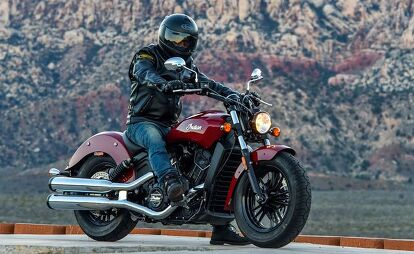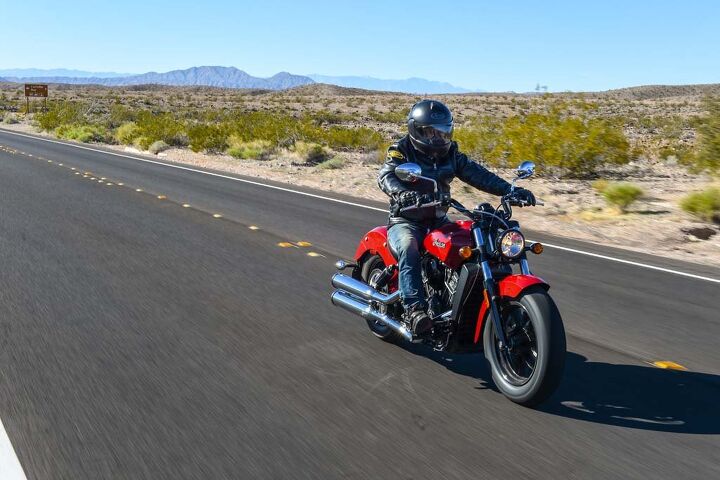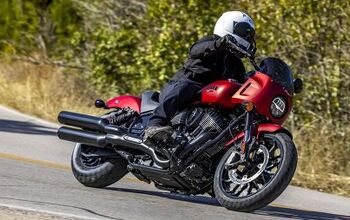2016 Indian Scout Sixty First Ride Review
134 fewer cc's and one less gear in the box feels like a great deal for $2K less
Personally, I feel like five speeds is plenty for a cruiser, really. Who wants to be shifting extra gears when they’re cruising relaxationally along feeling all Lee Marvin, having their chassis “further complimented by stout forks and shocks” like the press material for the new bike says? Why, thank you, forks and shocks, you’re not so bad yourself…
2016 Indian Scout Sixty
| Engine | 17.5/20 |
| Suspension/Handling | 12.0/15 |
| Transmission/Clutch | 8.0/10 |
| Brakes | 8.0/10 |
| Instruments/Controls | 4.5/5 |
| Ergonomics/Comfort | 7.5/10 |
| Appearance/Quality | 9.5/10 |
| Desirability | 8.5/10 |
| Value | 9.5/10 |
| Overall Score | 85/100 |
The other key difference from the original Indian Scout ( MO’s 2015 Motorcycle of the Year) is a simple sleeving down of the bike’s excellent liquid-cooled 60-degree V-Twin, from 1133cc to 999cc (69 to 61 cubic inches). That was accomplished with 6mm slimmer bores, down from 99 to 93mm diameter. Stroke remains 73.6mm, meaning this is still an oversquare Twin that doesn’t mind using its 4-valve DOHC heads to rev smack into the 8200-rpm limiter now and then if you so desire. Compression ratio for the smaller engine is a bit higher; up to 11:1 from the 10.7:1 of the 1133cc version.
Indian claims 100 hp for the big Scout, which translated to 83 at the rear wheel on the MotoGPWerks dyno last September. For the Sixty, they say 78 horses, which should put it at about 65 Dynojet horsies using the same “correction factor” – but it feels like more. Indian claimed 72 lb-ft. of torque for the bigger engine, which was 62.5 on our dyno at 5800 rpm. For the Sixty, Indian says 65 lb-ft at the same 5800 rpm.
But the most important number attached to the Scout Sixty is its price tag; it can’t be very much less expensive to build than the original Scout, seeing as they’re almost identical, but Indian wants nearly 20% less dollars for the Sixty – $8,999 for the black version ($300 more for red or white). About the only way to tell the Sixty from the Scout is that the large Scout has polished cam and engine covers and wheels, and a brown leather seat – and I think there’s a small “60” badge in the V of the motor on the left side of the Sixty. I’ll go out on a thick limb and guess Indian badly wanted a bike to compete with another American manufacturer’s least expensive biggish cruiser: Your H-D Sportster Iron 883 sells for $8,849.
| Gear ratios | Scout (1133 cc) | Scout Sixty |
| 1st | 10.782:1 | 10.782:1 |
| 2nd | 7.328:1 | 7.328:1 |
| 3rd | 5.841:1 | 5.841:1 |
| 4th | 4.957:1 | 4.957:1 |
| 5th | 4.380:1 | 4.034:1 |
| 6th | 4.034:1 | N/A |
As for the riding experience, like I started off saying, I think I actually prefer the Sixty’s five-speed, which requires 18% less shifting. Why does a cruiser need as many speeds as a MotoGP bike? The clutch is light at the lever but feels plenty stout for hard launches. Final-drive gearing is the same for the Sixty and the big Scout, but the Sixty doesn’t feel like its first is too tall nor its top gear too short: 80 mph in top has the tachometer reading 4200 rpm, just past halfway to redline.
At that speed the bike runs really smoothly with just a hint of V-Twin rumble coming through the grips and pegs; in fact it runs really smooth everywhere, including at idle. It does start to vibrate past about an indicated 95 mph, which matters barely at all since you’ll never go that fast. Much. The Sixty has plenty of power to easily push the speedo well past 100 mph, but I ran out of road past about 105 indicated.
It’ll also burble around town dropping as low as about 40 mph and 2000 rpm in fifth before you need to drop it down a gear. It uses the same 60mm throttle body as the bigger Scout. There’s sometimes the slightest hesitation when rolling back into the gas from trailing throttle, but not enough to complain about unless it’s your job to complain. Everywhere else, fuelling seems perfectly fine, and never a pop or backfire on decel either. All very civilized, yet at the same time the Sixty feels pretty spunky when you give it a big handfull. In fact, it doesn’t seem that much slower than the big Scout to me, probably because like with all smaller bikes, you work it harder, don’t you? Maybe the cruiser guys don’t like that. But I do.
The ride itself is indistinguishable from the big Scout, which makes sense since we’re told they have the exact same specs and suspension. It’s all gravy on smooth pavement and over small bumps, but big ones connect with your tailbone to remind you it’s those rear shocks where Indian economized. By cruiser standards, not so bad really; it’s the nature of the forward-footpegs beast. There’s supposed to be three inches of rear-wheel travel out back, which makes perfect sense because there will be air between your butt and the seat over any bump taller than three inches. For 2016, all the Scouts’ shocks get softer top-out bumpers, which should reduce the velocity of your butt leaving the seat.
The front end is more compliant and dialed, but that fat 16-inch front tire isn’t the most communicative or planted-feeling at speed. Again, it’s not supposed to be a MotoGP bike anyway. In fact, the thing steers light and quick enough when you ask it to, and has a reasonable amount of cornering clearance.
Both Scouts’ single 298mm front discs use a cheapie two-piston slide-type caliper not unlike the terrible one H-D put on the Street 750 (that’s been upgraded for ’16, we hear), but Indian did it right. There’s plenty of strong, progressive stopping power, especially when you use the other 298mm disc out back. (No ABS on US models; the ABS bike in Europe will sell for €11,990, which is $12,765 today.)
Comfortwise, the seat’s thick enough and I felt great after about a half day sitting on it, though we do stop a lot on press junkets to shoot pictures and eat and wait for lost people to get found and whatnot. As for me, I’d rather have the footpegs further rearward. There was a bike along for the ride outfitted with Indian’s “reduced reach” kit, but I could never find it when I wanted to ride it. Might be better, as my arms are apparently as short as my legs – which easily flat-foot the pavement on this bike. My throttle paw was tired of having to reach forward and hold on the gas by the end of the day and might’ve liked it better if it had only had to do one or the other. Also, like the bigger Scout, there’s no place for a friend on the Sixty, so you’ll be needing another $370 or so for the optional passenger seat and pegs. (Oh, look! There’s new Indian Performance Shocks by Fox in the catalog now, too, and $899 is only 10% as much as the whole motorcycle.)
Okay, so the Sixty’s a little slower than the full-size Scout, but if it’s a real high-performance motorcycle you’re after, you’re sort of shopping in the wrong aisle anyway. By cruiser metrics, the Sixty feels perfectly fast enough to me and not that much slower than the big Scout when you’re giving it the ol’ whip – and it’ll blow its nearest competitor, the 883 Sportster, completely away in any performance contest as well as in any sophistication one. Now that we’ve had a year to digest the new Scout’s looks, I have to say I think they did a fantastic job hiding a pretty sweet, smooth-running and powerful modern motorcycle under a skin that projects classic Indian looks very nicely into the jet age. (And we need to get our hands on some of those Fox shocks (at a substantial discount)).
2016 Indian Scout Sixty
+ Highs
- The 5-speed trans is really no sacrifice at all
- 999cc used to be plenty big and it still is
- The $8,999 black cheapest one is the prettiest one
– Sighs
- Rear suspension is still harsh on bumps 2.97 inches and taller
- 3.3-gallon fuel capacity is not enough
- Indian’s going to lose money on this bike (ok, probably they’re not)
2016 Indian Scout Sixty Specifications | |
|---|---|
| Engine Type | Liquid-cooled 60-degree V-Twin; 4V/cyl, DOHC |
| Engine Capacity | 999 cc |
| Bore x Stroke | 93.0mm x 73.6mm |
| Horsepower | 78 hp (claimed) |
| Torque | 65 ft-lb at 5800 rpm (claimed) |
| Compression ratio | 11 : 1 |
| Fuel System | EFI, 60mm throttle-body |
| Clutch | Wet, multi-plate |
| Transmission | 5-speed constant-mesh |
| Final Drive | Belt |
| Front Suspension | 41mm telescopic fork; 4.7-in travel |
| Rear Suspension | Dual coil-over shocks; 3-in travel |
| Front Brake | 298mm disc; 2-piston slide-type caliper |
| Rear Brake | 298mm disc, single-piston caliper |
| Front Tire | Kenda K673F 130/90-16 |
| Rear Tire | Kenda K673 150/80-16 |
| Seat Height | 25.3 in |
| Rake/Trail | 29°/4.7 in |
| Wheelbase | 61.5 in |
| Ground clearance | 5.3 in |
| Dry Weight (Claimed) | 542 lb |
| Fuel Capacity | 3.3 gal |
| Colors | Black, Red, White |
| MSRP | $8,999 (Black), $9,299 (Red or White) |
More by John Burns
































































Comments
Join the conversation
Buying a "used" bike is easy. It's a lot like watching re-runs of a TV show. No big commitments during prime-time... But, buying a "new" bike is a prime-time commitment requiring more comparisons and more in depth decision making.
When shopping cars one might visit several different dealerships before making a decision and it's usually the one that pulls away from the rest that is worth the haggling...
Harley's Sportster line-up features different styled motorcycles. The 883 Iron has little in common with the 1200 Custom. Same as the Super-Low, etc... They all live under the Sportster moniker, but they are different bikes at different price points.
What it appears Indian has done with the addition of their "60" is take their Scout and create an mirror version of it, removing certain features for the sake of cost. No one purchasing a new bike wants to feel like they lack funds or went bargain hunting. To me, buying a "60" would come with that sort of label.
If the "60" had different styling or purpose, I could shop both bikes at the same dealership, but I think it's going to confuse buyers and make them have to think more about it. And we know dealerships want buyers to do less thinking and partake in knee-jerk buying...
The Scout and the "60" appear more like big brother-little brother (mini-me) and in the world of motorcycle design that's just a cheap trick-
I had the Yamaha XVS650 and that bike was crying out for a 6th gear on the highway and some reviewers have commented the larger Yamaha need that 6th gear to. I suppose if you wish for a cruiser like the big Scout to only have 5 gears just don't use the 6th gear.